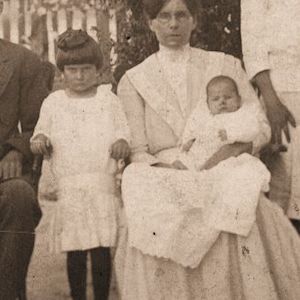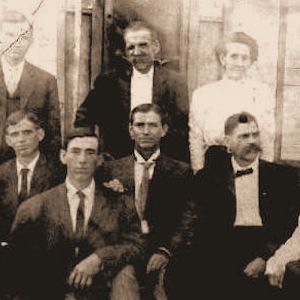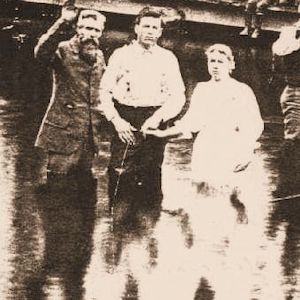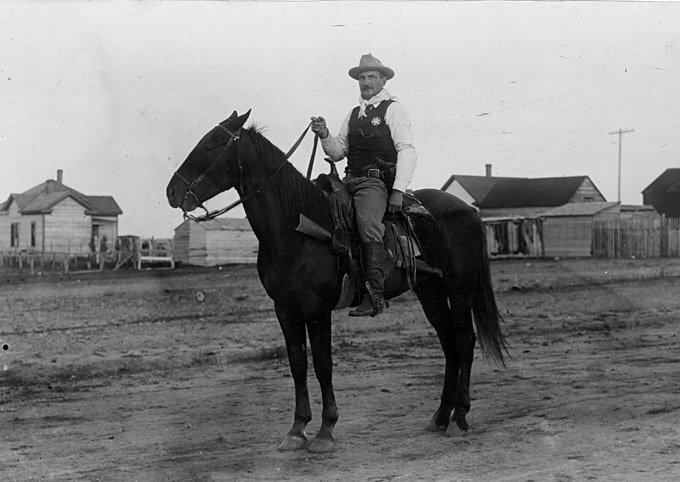




Your Text Here
I am Rebecca Maloney, Temporary Webmistress and Coordinator for this Campbell County Wyoming site. I hope you enjoy your visit. Please email me if you have any suggestions or contributions you would like to make.

Campbell County, in northeastern Wyoming, is part of the Powder River Basin, which stretches from the crest of the Bighorn Mountains to the western Black Hills. A perfect habitat for the North American bison and other large mammals, for generations the region was a valued hunting ground for American Indians, especially the Lakota Sioux. The rectangle of present-day Campbell County, approximately 4,761 square miles, is mostly grassland over extensive sub-bituminous coal deposits dating from the Cretaceous and Tertiary Periods. Some of the coal deposits in the Powder River Basin are so close to the surface that early settlers could dig their own coal. Campbell County’s coal is low in sulfur compared to coal mined in the eastern United States. Since 1990, when the Clean Air Act was amended to require electric utilities to reduce sulfur emissions from their coal-fired power plants, Campbell County’s low-sulfur coal has enjoyed distinct advantages in the national market—despite the long distances the coal is often shipped to utilities in the Midwest and South. Campbell County is bordered on the south by the counties of Converse and Niobrara; on the east by Weston and Crook; on the west by Johnson and Sheridan; and on the north by the state of Montana. Although the Powder River flows through only the far northwest corner of Campbell County, the river’s south-to-north course roughly parallels the western border of the county, just across the Johnson and Sheridan County lines. Ancient Times and Early Explorers Ancient deposits of bison bone establishing the presence of Paleo-Indians have been found at various points in Campbell County. The Ruby Site near Pumpkin Buttes in the southwest corner of the county is one of the best known. It is a bison pound—an ingenious structure similar in design to a modern-day cattle corral, though likely much stronger. It was probably used by the Besant hunters around A.D. 100 or shortly afterward. An older site from perhaps 10,000 years ago is the Carter/Kerr-McGee site north of Gillette, Wyo., excavated in 1975 before the opening of the Carter/Kerr-McGee coal mine. There, a bison butchering area was found and, nearby, an arroyo that probably formed a natural trap into which the animals could be driven. This site indicated the presence of the Goshen, Folsom, Agate Basin, Hell Gap, and Alberta-Cody cultures. Prehistoric cultures are generally named for the places where artifacts identifying them were first found. Campbell County Sheriff Lew Butler, ca. 1912. Rockpile Museum. The first American explorer-trapper to travel through the area that is now Campbell County was probably Francois-Antoine Larocque in 1805, trading with the Crow Indians on behalf of the Montreal-based North West Company. John Colter visited the area in 1807-1808, followed in 1811 by Wilson Price Hunt and a party of men sent by fur-trade tycoon John Jacob Astor. This group, the "overland Astorians," crossed the basin on their way to the Columbia River drainage. Then, in 1828, Robert Campbell and a party of men from the Rocky Mountain Fur Company traveled through, trapping for beaver along Powder River. The peripatetic missionary Father Pierre-Jean DeSmet passed by the Pumpkin Buttes in 1851, and referred to them in a diary entry as the "Gourd Buttes." The Bozeman Trail, a route from the Oregon Trail along the North Platte River to newly discovered gold fields in Montana Territory, passed through the southwest corner of what’s now Campbell County. It was traveled by prospectors and settlers starting in 1864. Attacks by the Cheyenne, Lakota Sioux and Arapaho were common, earning the trail its nickname, the Bloody Bozeman. To protect the white travelers, the U.S. Army was ordered to patrol the trail, and for four years there were many fights and skirmishes in what came to be called Red Cloud’s War. In the Fort Laramie Treaty of 1868, the Powder River Basin was relegated to the Sioux, Cheyenne and Arapaho. Only eight years later, on Jan. 31, 1876, the U.S. government proclaimed that all the Indians must move to reservations. More warfare followed. By 1878, the area was open to white people. Early settlement and cattle ranching The earliest cattle drive from Texas to Montana passed through northeast Wyoming in 1866. In the late 1870s, cattle ranches began to be established, and with the end of the Indian threats, white settlement began in earnest. Although the winter of 1886-1887 destroyed many large herds and ended the open range era, some cattle ranching continued. Ranchers began to grow their own hay for cattle feed or sometimes shipped herds to out-of-state winter feeding locations. Published by Rebecca Hein Saturday, November 8, 2014
County boundaries and organization
The area that would eventually become Campbell County began as part of Albany County, Wyoming Territory in 1869. In 1875, the territorial legislature created Crook County out of the northern halves of Albany and Laramie Counties; Crook County took up the entire northeast corner of the territory. Future Campbell County would occupy the western half of this area. First, however, in 1890, Weston County was created from the southern half of Crook County, with a boundary stretching from the Nebraska state line to Johnson County.
Finally, with the creation of Campbell County by an act of the state legislature on Feb. 13, 1911, and the organization of its government on Jan. 6, 1913, the western halves of Crook and Weston counties were sliced by a north-south line running from the Montana state line to the Converse County border. (Converse County had been formed in 1888 out of other parts of the original Albany and Laramie counties.)
There is some dispute about who the county was named for--either Robert Campbell, the early fur trader mentioned above, or John A. Campbell, the first territorial governor of Wyoming. According to the Wyoming Blue Book, some sources "probably trying to make peace, claim Campbell County was named for both men."
Make sure you check the "Research Resources" section!

|
|||
| search engine by freefind |
CAMPBELL COUNTY |
||
| CONVERSE COUNTY |
|
If you have questions, contributions, or problems with this site, email:
Coordinator - Available for Adoption
Acting State Coordinator: Rebecca Maloney
Asst. State Coordinators: Rebecca Maloney
If you have questions or problems with this site, email the County Coordinator. Please to not ask for specfic research on your family. I am unable to do your personal research.